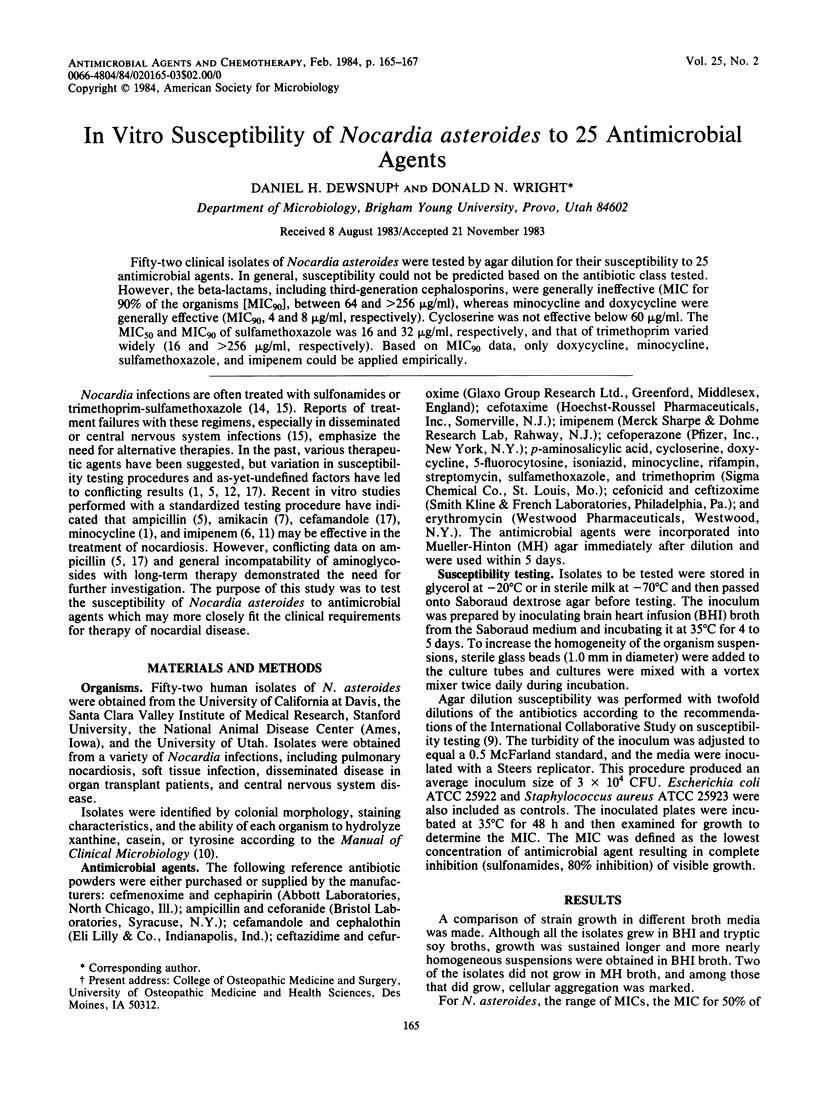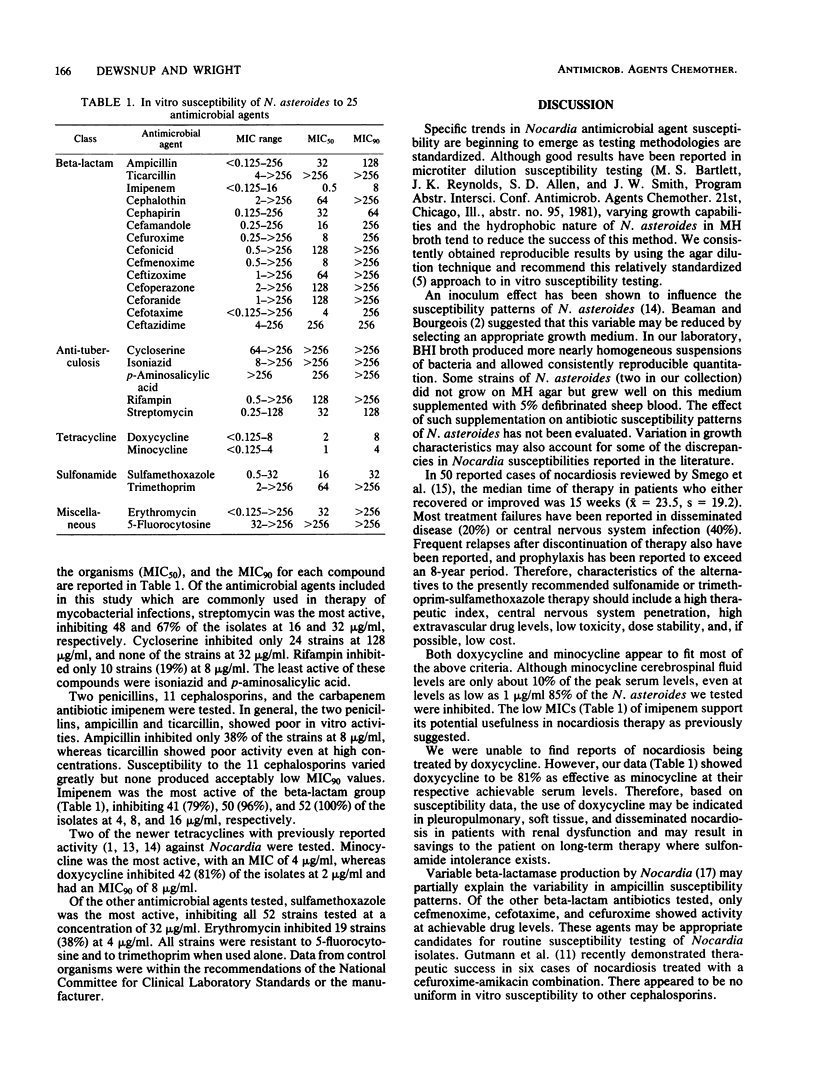Abstract
Fifty-two clinical isolates of Nocardia asteroides were tested by agar dilution for their susceptibility to 25 antimicrobial agents. In general, susceptibility could not be predicted based on the antibiotic class tested. However, the beta-lactams, including third-generation cephalosporins, were generally ineffective (MIC for 90% of the organisms [MIC90], between 64 and greater than 256 micrograms/ml), whereas minocycline and doxycycline were generally effective (MIC90, 4 and 8 micrograms/ml, respectively). Cycloserine was not effective below 60 micrograms/ml. The MIC50 and MIC90 of sulfamethoxazole was 16 and 32 micrograms/ml, respectively, and that of trimethoprim varied widely (16 and greater than 256 micrograms/ml, respectively). Based on MIC90 data, only doxycycline, minocycline, sulfamethoxazole, and imipenem could be applied empirically.
Full text
PDF


Selected References
These references are in PubMed. This may not be the complete list of references from this article.
- Bach M. C., Sabath L. D., Finland M. Susceptibility of Nocardia asteroides to 45 antimicrobial agents in vitro. Antimicrob Agents Chemother. 1973 Jan;3(1):1–8. doi: 10.1128/aac.3.1.1. [DOI] [PMC free article] [PubMed] [Google Scholar]
- Beaman B. L., Bourgeois A. L., Moring S. E. Cell wall modification resulting from in vitro induction of L-phase variants of Nocardia asteroides. J Bacteriol. 1981 Nov;148(2):600–609. doi: 10.1128/jb.148.2.600-609.1981. [DOI] [PMC free article] [PubMed] [Google Scholar]
- Beaman B. L., Bourgeois L. Variations in properties of Nocardia asteroides resulting from growth in the cell wall-deficient state. J Clin Microbiol. 1981 Nov;14(5):574–578. doi: 10.1128/jcm.14.5.574-578.1981. [DOI] [PMC free article] [PubMed] [Google Scholar]
- Beaman B. L., Scates S. M. Role of L-forms of Nocardia caviae in the development of chronic mycetomas in normal and immunodeficient murine models. Infect Immun. 1981 Sep;33(3):893–907. doi: 10.1128/iai.33.3.893-907.1981. [DOI] [PMC free article] [PubMed] [Google Scholar]
- Carroll G. F., Brown J. M., Haley L. D. A method for determining in-vitro drug susceptibilities of some Nocardiae and Actinomadurae: results with 17 antimicrobial agents. Am J Clin Pathol. 1977 Aug;68(2):279–283. doi: 10.1093/ajcp/68.2.279. [DOI] [PubMed] [Google Scholar]
- Cynamon M. H., Palmer G. S. In vitro susceptibility of Nocardia asteroides to N-formimidoyl thienamycin and several cephalosporins. Antimicrob Agents Chemother. 1981 Dec;20(6):841–842. doi: 10.1128/aac.20.6.841. [DOI] [PMC free article] [PubMed] [Google Scholar]
- Dalovisio J. R., Pankey G. A. In vitro susceptibility of Nocardia asteroides to amikacin. Antimicrob Agents Chemother. 1978 Jan;13(1):128–129. doi: 10.1128/aac.13.1.128. [DOI] [PMC free article] [PubMed] [Google Scholar]
- Davis-Scibienski C., Beaman B. L. Interaction of alveolar macrophages with Nocardia asteroides: immunological enhancement of phagocytosis, phagosome-lysosome fusion, and microbicidal activity. Infect Immun. 1980 Nov;30(2):578–587. doi: 10.1128/iai.30.2.578-587.1980. [DOI] [PMC free article] [PubMed] [Google Scholar]
- Gutmann L., Goldstein F. W., Kitzis M. D., Hautefort B., Darmon C., Acar J. F. Susceptibility of Nocardia asteroides to 46 antibiotics, including 22 beta-lactams. Antimicrob Agents Chemother. 1983 Feb;23(2):248–251. doi: 10.1128/aac.23.2.248. [DOI] [PMC free article] [PubMed] [Google Scholar]
- Lerner P. I., Baum G. L. Antimicrobial susceptibility of Nocardia species. Antimicrob Agents Chemother. 1973 Aug;4(2):85–93. doi: 10.1128/aac.4.2.85. [DOI] [PMC free article] [PubMed] [Google Scholar]
- Simpson G. L., Stinson E. B., Egger M. J., Remington J. S. Nocardial infections in the immunocompromised host: A detailed study in a defined population. Rev Infect Dis. 1981 May-Jun;3(3):492–507. doi: 10.1093/clinids/3.3.492. [DOI] [PubMed] [Google Scholar]
- Smego R. A., Jr, Moeller M. B., Gallis H. A. Trimethoprim-sulfamethoxazole therapy for Nocardia infections. Arch Intern Med. 1983 Apr;143(4):711–718. [PubMed] [Google Scholar]
- Tsukamura M. Differentiation between the genera Mycobacterium, Rhodococcus and Nocardia by susceptibility to 5-fluorouracil. J Gen Microbiol. 1981 Jul;125(1):205–208. doi: 10.1099/00221287-125-1-205. [DOI] [PubMed] [Google Scholar]
- Wallace R. J., Jr, Vance P., Weissfeld A., Martin R. R. Beta-lactamase production and resistance to beta-lactam antibiotics in Nocardia. Antimicrob Agents Chemother. 1978 Nov;14(5):704–709. doi: 10.1128/aac.14.5.704. [DOI] [PMC free article] [PubMed] [Google Scholar]


